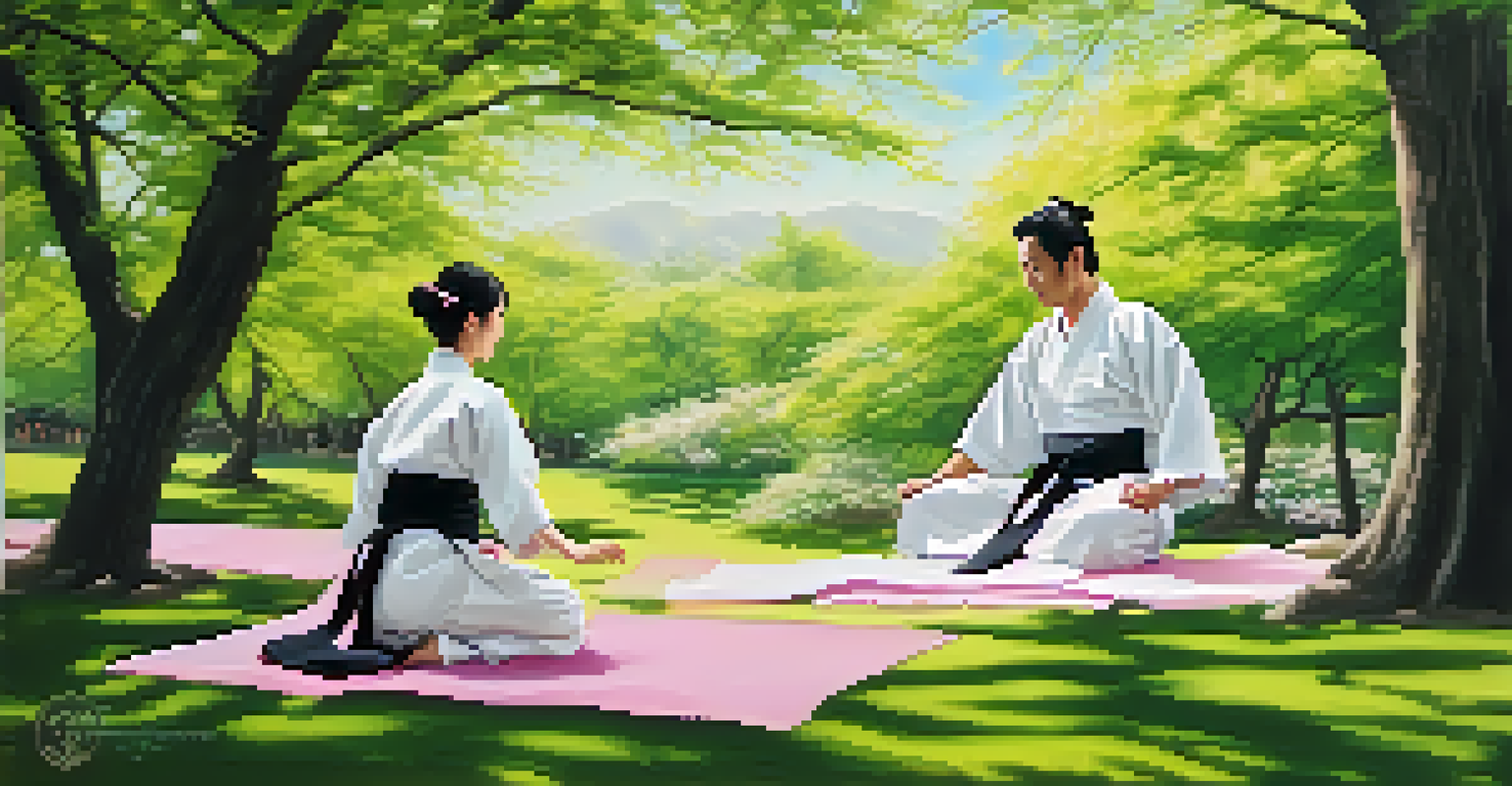Aikido Principles: Techniques and Philosophy of Harmony in Action

Understanding Aikido: A Path to Harmony and Peace
Aikido is more than just a martial art; it embodies a philosophy of harmony and peace. Developed by Morihei Ueshiba, it focuses on blending with an opponent’s movements rather than opposing them directly. This approach allows practitioners to neutralize aggression without causing harm, making Aikido unique among martial arts.
The ultimate aim of Aikido is to create a world in which people live in harmony with one another.
The essence of Aikido lies in the principle of 'Aiki,' which translates to 'joining energy.' This concept encourages practitioners to harmonize with their partner's intentions, creating a fluid dance of movement rather than a clash of forces. In this way, Aikido teaches us that true strength comes from understanding and cooperation rather than brute force.
Ultimately, Aikido serves as a metaphor for life. It encourages us to approach conflicts with a mindset of resolution and understanding, promoting peace not just on the mat but in our daily interactions. This philosophy resonates with many who seek a deeper connection to themselves and others.
The Core Principles of Aikido: Centering and Balance
At the heart of Aikido are principles that emphasize centering and balance. Centering refers to maintaining one's physical and mental stability, allowing practitioners to respond effectively to an attack. This principle teaches us that when we are grounded and centered, we can navigate challenges with grace and composure.

Balance, on the other hand, is about aligning our body and mind. In Aikido, we learn to maintain our balance while moving fluidly, which helps us evade or redirect incoming energy. This principle not only applies to physical techniques but also serves as a reminder to seek balance in our everyday lives.
Aikido: Harmony Over Conflict
Aikido teaches practitioners to blend with an opponent's energy, promoting conflict resolution through understanding instead of aggression.
By focusing on centering and balance, Aikido practitioners cultivate a sense of inner peace and resilience. These principles serve as the foundation for executing techniques effectively while promoting a harmonious state of being.
Techniques of Aikido: Flowing Movement and Joint Locks
Aikido techniques are characterized by flowing movements that redirect an opponent's energy. Techniques such as iriminage and kotegaeshi illustrate this principle, allowing practitioners to blend with their partner's motions rather than resist them. This fluidity creates a sense of harmony, making Aikido feel like a graceful dance.
To be able to take a punch is not the essence of Aikido. The essence lies in the ability to blend and redirect the energy of the opponent.
Joint locks and throws are also essential techniques in Aikido. They not only demonstrate control over an opponent but also emphasize the importance of using their energy against them. Practitioners learn to apply these techniques safely, ensuring that both they and their partner remain unharmed during training.
These techniques highlight Aikido's core philosophy: conflict can be resolved without violence. By mastering these movements, practitioners develop a deeper understanding of human interaction and conflict resolution, both on and off the mat.
The Role of Mindfulness in Aikido Practice
Mindfulness plays a crucial role in Aikido practice, enhancing both technique and philosophy. Practitioners are encouraged to remain present during training, focusing on their breath and movements. This mindfulness cultivates a deeper connection to oneself and others, fostering a sense of awareness that is vital in martial arts.
Being mindful allows practitioners to respond to attacks with clarity and intention. Instead of reacting out of fear or panic, they learn to observe and adapt to the situation at hand. This skill not only improves their Aikido practice but also enriches their daily lives by promoting thoughtful responses to challenges.
Mindfulness Enhances Aikido Practice
Incorporating mindfulness into Aikido fosters awareness and clarity, allowing practitioners to respond thoughtfully to challenges.
Incorporating mindfulness into Aikido teaches valuable lessons about patience and presence. These qualities can transform our interactions, making us more empathetic and understanding individuals.
The Importance of Respect and Etiquette in Aikido
Respect and etiquette are foundational elements in Aikido training. Practitioners bow to each other and their instructors, acknowledging the shared space and the learning process. This simple act of respect fosters a sense of community and mutual understanding among students.
Etiquette extends beyond physical gestures; it also encompasses the way practitioners interact with one another. Learning to give and receive corrections graciously promotes a supportive environment, encouraging growth and development. This culture of respect enhances the overall training experience.
By valuing respect and etiquette, Aikido practitioners embody the principles of harmony and cooperation. These qualities not only enrich the practice but also serve as essential life skills that can be applied in various social contexts.
The Philosophy of Non-Resistance in Aikido
Aikido's philosophy emphasizes non-resistance, teaching us to accept situations as they are rather than fighting against them. This principle encourages practitioners to flow with an opponent's energy instead of opposing it, leading to more effective techniques and resolutions. Learning to let go of resistance can be transformative in all aspects of life.
Non-resistance doesn’t mean passivity; rather, it promotes a proactive approach to conflict. By accepting the circumstances, practitioners can redirect energy in a constructive way, often leading to peaceful outcomes. This mindset can help us navigate personal conflicts, work-related challenges, and even societal issues.
Respect and Etiquette Cultivate Growth
Valuing respect and etiquette in Aikido creates a supportive environment that enhances training and builds essential life skills.
Embracing non-resistance in Aikido cultivates a sense of inner calm and clarity. It teaches us that sometimes the best way to confront a challenge is not through force but through understanding and adaptability.
Aikido as a Path of Personal Growth and Development
Practicing Aikido is not just about mastering techniques; it's also a journey of personal growth and self-discovery. The challenges faced on the mat mirror those in everyday life, encouraging practitioners to overcome obstacles with grace and resilience. Each training session presents an opportunity for reflection and improvement.
Through Aikido, individuals develop qualities such as patience, humility, and perseverance. These traits are essential for personal growth and can positively impact various aspects of life, from relationships to career pursuits. The lessons learned on the mat often extend far beyond martial arts.

As practitioners continue their Aikido journey, they cultivate a deeper understanding of themselves and their connection to others. This path of growth fosters a sense of purpose and fulfillment, making Aikido a holistic practice that nurtures both body and spirit.